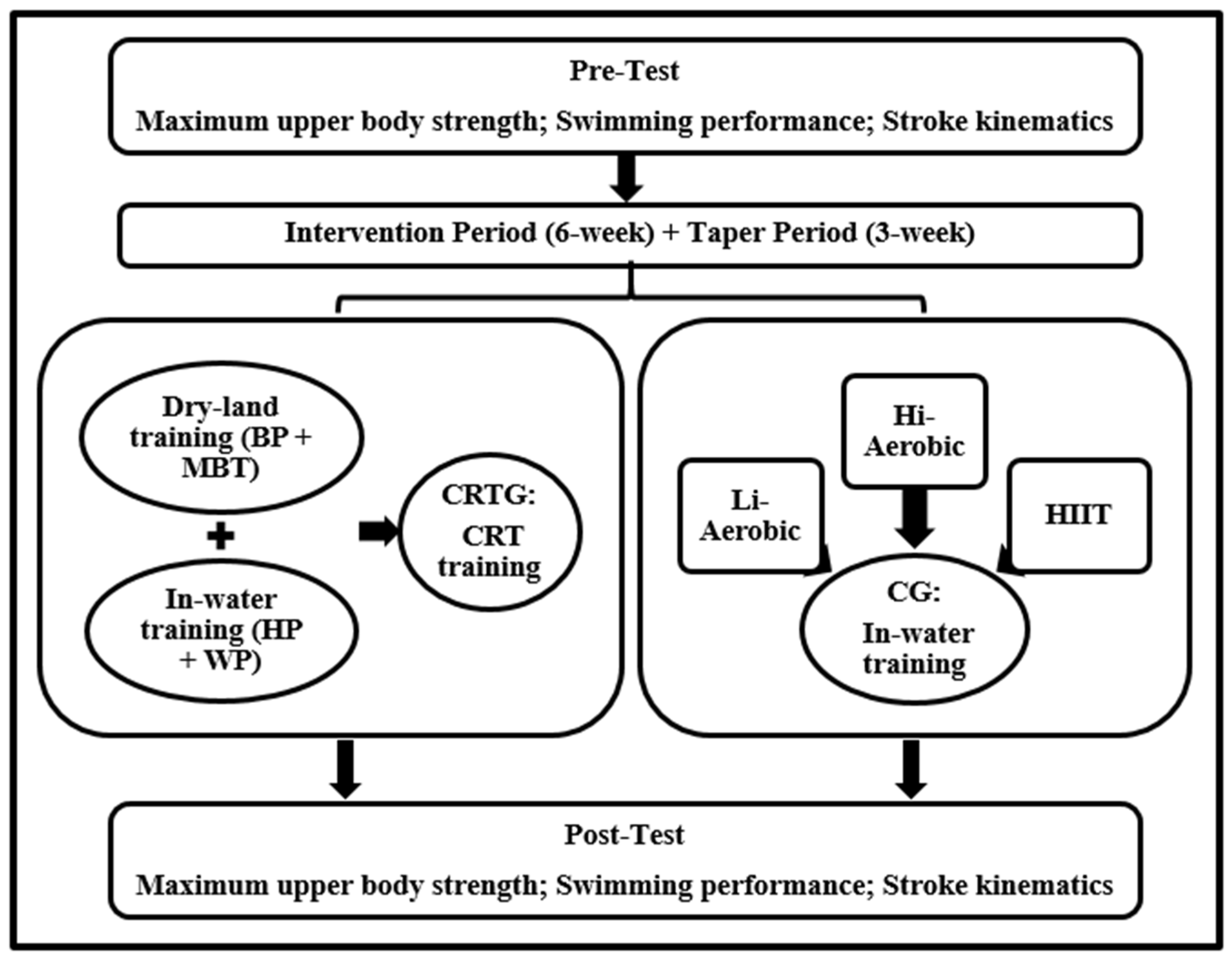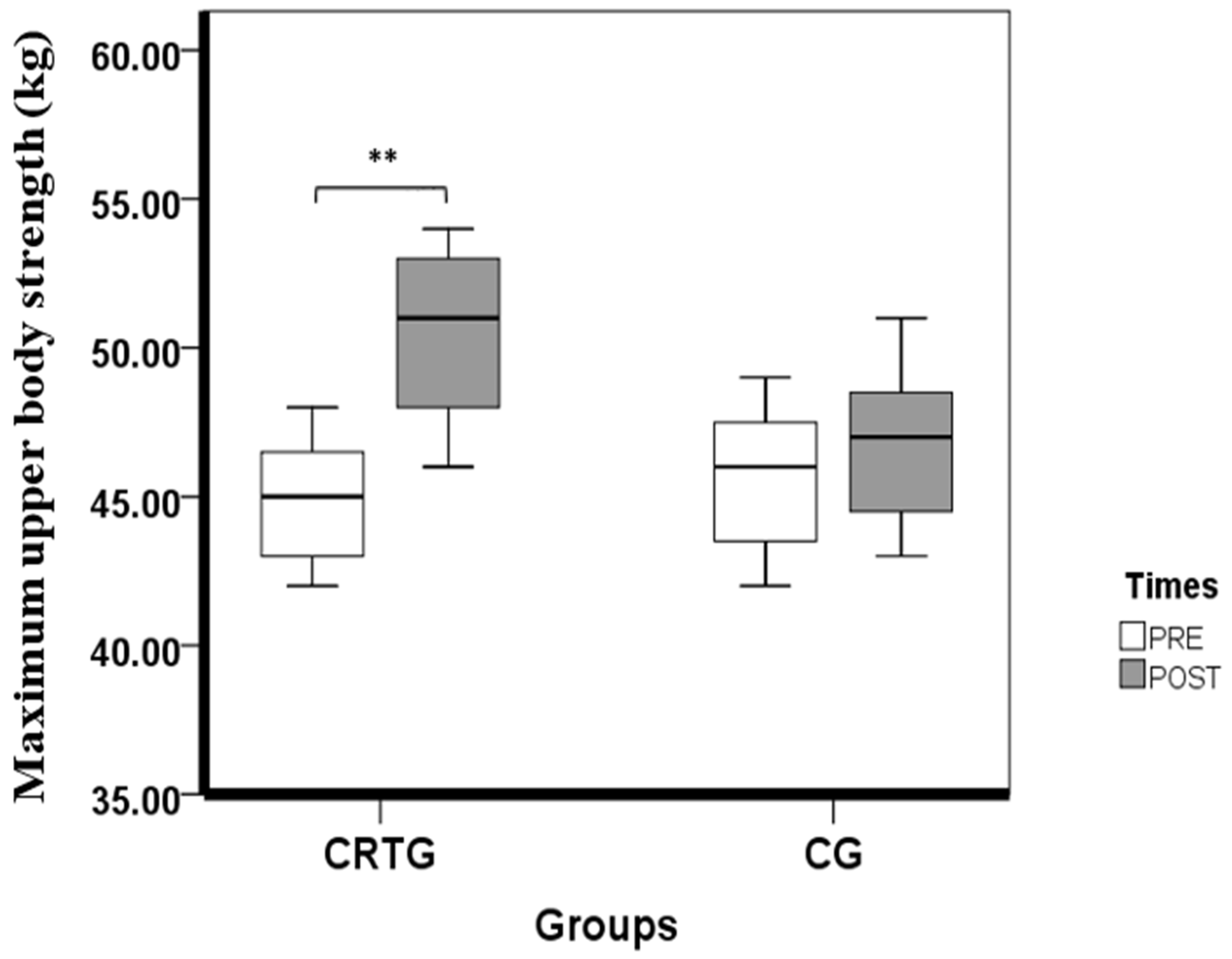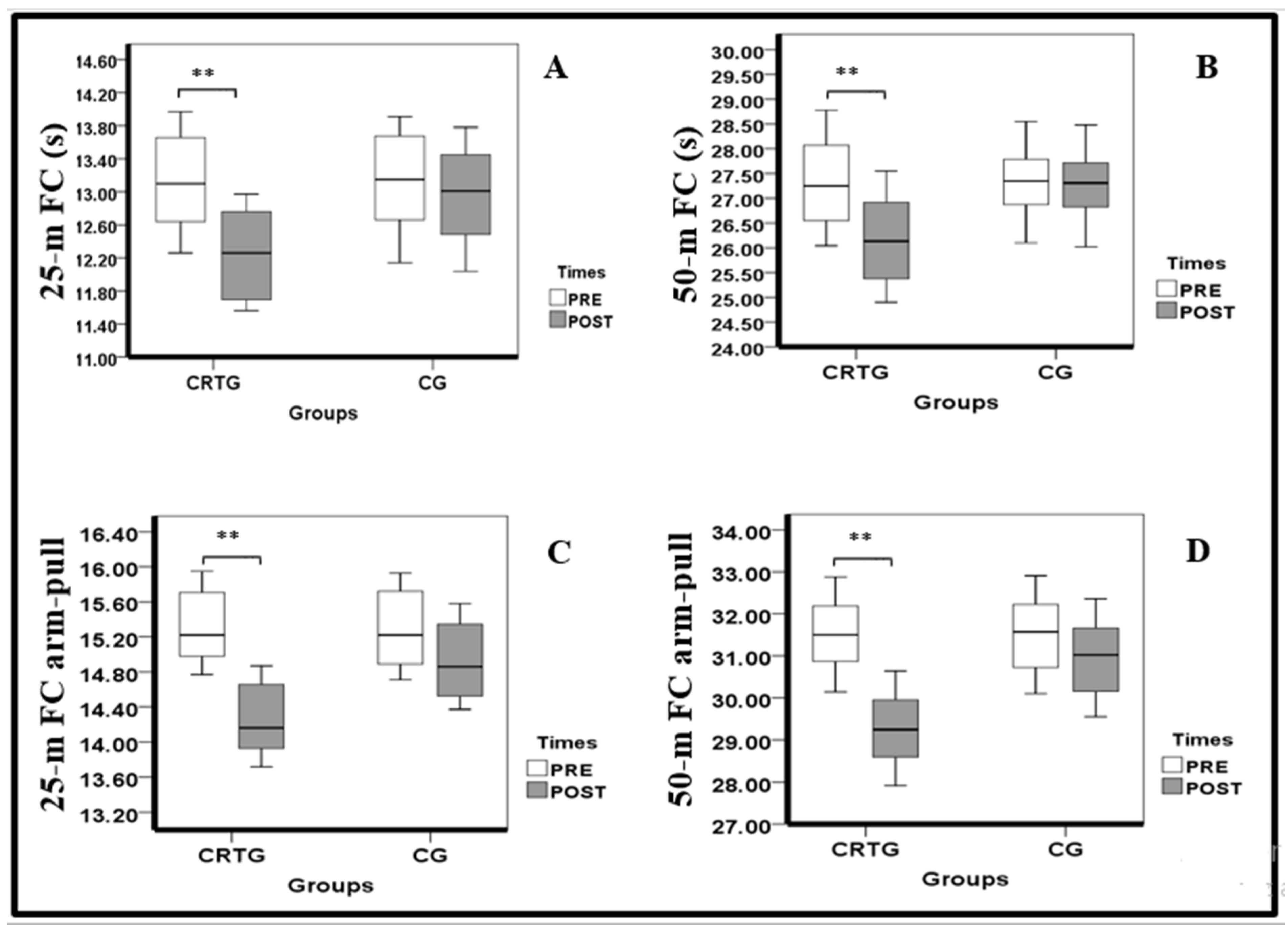The Effect of Concurrent Resistance Training on Upper Body Strength, Sprint Swimming Performance and Kinematics in Competitive Adolescent Swimmers. A Randomized Controlled Trial
Abstract
1. Introduction
2. Materials and Methods
2.1. Experimental Approach to the Problem
2.2. Participants
2.3. Procedure
2.3.1. Concurrent Resistance Training (CRT)
2.3.2. Resistance Training in Dry Land
2.3.3. Resistance Training in Water
2.3.4. Maximum Upper Body Strength Test
2.3.5. Sprint Swimming Performance Tests
2.3.6. Kinematic Variables
2.4. Statistical Analysis
3. Results
3.1. Effect of Training on Maximum Upper Body Strength
3.2. Effect of Training on Sprint Swimming Performance
3.3. Effect of Training on the Kinematic Variables
4. Discussion
4.1. Effect of Training on Maximum Upper Strength
4.2. Effect of Training on Sprint Swimming Performance
4.3. Effect of Training on Kinematic Variables
5. Conclusions
Author Contributions
Funding
Acknowledgments
Conflicts of Interest
References
- Lum, D.; Tiago, M.B. Effects of Strength Training on Olympic Time-Based Sport Performance: A Systematic Review and Meta-Analysis of Randomized Controlled Trials. Int. J. Sports Physiol. Perform. 2019, 14, 1318. [Google Scholar] [CrossRef] [PubMed]
- Sammoud, S.; Negra, Y.; Bouguezzi, R.; Hachana, Y.; Granacher, U.; Chaabene, H. The effects of plyometric jump training on jump and sport-specific performances in prepubertal female swimmers. J. Exerc. Sci. Fit. 2021, 19, 25–31. [Google Scholar] [CrossRef]
- Sammoud, S.; Negra, Y.; Chaabene, H.; Bouguezzi, R.; Moran, J.; Granacher, U. The Effects of Plyometric Jump Training on Jumping and Swimming Performances in Prepubertal Male Swimmers. J. Sports Sci. Med. 2019, 18, 805–811. [Google Scholar] [PubMed]
- Keiner, M.; Rähse, H.; Wirth, K.; Hartmann, H.; Fries, K.; Haff, G.G. Influence of Maximal Strength on In-Water and Dry-Land Performance in Young Water Polo Players. J. Strength Cond. Res. 2020, 34, 1999–2005. [Google Scholar] [CrossRef] [PubMed]
- Keiner, M.; Wirth, K.; Fuhrmann, S.; Kunz, M.; Hartmann, H.; Haff, G.G. The Influence of Upper- and Lower-Body Maximum Strength on Swim Block Start, Turn, and Overall Swim Performance in Sprint Swimming. J. Strength Cond. Res. 2019. [Google Scholar] [CrossRef] [PubMed]
- Gourgoulis, V.; Valkoumas, I.; Boli, A.; Aggeloussis, N.; Antoniou, P. Effect of an 11-Week In-Water Training Program With Increased Resistance on the Swimming Performance and the Basic Kinematic Characteristics of the Front Crawl Stroke. J. Strength Cond. Res. 2019, 33, 95–103. [Google Scholar] [CrossRef] [PubMed]
- Lopes, T.J.; Neiva, H.P.; Gonçalves, C.A.; Nunes, C.; Marinho, D.A. The effects of dry-land strength training on competitive sprinter swimmers. J. Exerc. Sci. Fit. 2021, 19, 32–39. [Google Scholar] [CrossRef]
- Crowley, E.; Harrison, A.J.; Lyons, M. Dry-Land Resistance Training Practices of Elite Swimming Strength and Conditioning Coaches. J. Strength Cond. Res. 2018, 32, 2592–2600. [Google Scholar] [CrossRef]
- Barbosa, A.C.; Ferreira, T.; Leis, L.V.; Gourgoulis, V.; Barroso, R. Does a 4-week training period with hand paddles affect front-crawl swimming performance? J. Sports Sci. 2020, 38, 511–517. [Google Scholar] [CrossRef]
- Crowley, E.; Harrison, A.J.; Lyons, M. The Impact of Resistance Training on Swimming Performance: A Systematic Review. Sports Med. 2017, 47, 2285–2307. [Google Scholar] [CrossRef]
- Haycraft, J.; Robertson, S. The effects of concurrent aerobic training and maximal strength, power and swim-specific dry-land training methods on swim performance: A review. J. Aust. Strength Cond. 2015, 23, 91–99. [Google Scholar]
- Telles, T.; Barbosa, A.C.; Campos, M.H.; Junior, O.A. Effect of hand paddles and parachute on the index of coordination of competitive crawl-strokers. J. Sports Sci. 2011, 29, 431–438. [Google Scholar] [CrossRef] [PubMed]
- Martens, J.; Figueiredo, P.; Daly, D. Electromyography in the four competitive swimming strokes: A systematic review. J. Electromyogr. Kinesiol. 2015, 25, 273–291. [Google Scholar] [CrossRef] [PubMed]
- Ignjatovic, A.M.; Markovic, Z.M.; Radovanovic, D.S. Effects of 12-week medicine ball training on muscle strength and power in young female handball players. J. Strength Cond. Res. 2012, 26, 2166–2173. [Google Scholar] [CrossRef]
- Raeder, C.; Fernandez-Fernandez, J.; Ferrauti, A. Effects of Six Weeks of Medicine Ball Training on Throwing Velocity, Throwing Precision, and Isokinetic Strength of Shoulder Rotators in Female Handball Players. J. Strength Cond. Res. 2015, 29, 1904–1914. [Google Scholar] [CrossRef] [PubMed]
- Crocker, G.H.; Moon, J.F.; Nessler, J.A.; Newcomer, S.C. Energetics of Swimming with Hand Paddles of Different Surface Areas. J. Strength Cond. Res. 2021, 35, 205–211. [Google Scholar] [CrossRef] [PubMed]
- Morais, J.E.; Silva, A.J.; Marinho, D.A.; Marques, M.C.; Barbosa, T.M. Effect of a specific concurrent water and dry-land training over a season in young swimmers’ performance. Int. J. Perform. Anal. Sport 2016, 16, 760–775. [Google Scholar] [CrossRef][Green Version]
- McGowan, C.J.; Pyne, D.B.; Raglin, J.S.; Thompson, K.G.; Rattray, B. Current Warm-Up Practices and Contemporary Issues Faced by Elite Swimming Coaches. J. Strength Cond. Res. 2016, 30, 3471–3480. [Google Scholar] [CrossRef]
- Williams, T.D.; Esco, M.R.; Fedewa, M.V.; Bishop, P.A. Bench Press Load-Velocity Profiles and Strength after Overload and Taper Microcyles in Male Powerlifters. J. Strength Cond. Res. 2020, 34, 3338–3345. [Google Scholar] [CrossRef]
- Pritchard, H.; Keogh, J.; Barnes, M.; McGuigan, M. Effects and mechanisms of tapering in maximizing muscular strength. Strength Cond. J. 2015, 37, 72–83. [Google Scholar] [CrossRef]
- Telles, T.; Barroso, R.; Figueiredo, P.; Salgueiro, D.F.; Vilas-Boas, J.P.; Junior, O.A. Effect of hand paddles and parachute on backstroke coordination and stroke parameters. J. Sports Sci. 2017, 35, 906–911. [Google Scholar] [CrossRef] [PubMed]
- Benton, M.J.; Raab, S.S.; Waggener, G.T. Effect of training status on reliability of one repetition maximum testing in women. J. Strength Cond. Res. 2013, 27, 1885–1890. [Google Scholar] [CrossRef]
- Ferraresi, C.; Baldissera, V.; Perez, S.E.; Junior, E.M.; Bagnato, V.S.; Parizotto, N.A. One-repetition maximum test and isokinetic leg extension and flexion: Correlations and predicted values. Isokinet. Exerc. Sci. 2013, 21, 69–76. [Google Scholar] [CrossRef]
- Foster, C.; Florhaug, J.A.; Franklin, J.; Gottschall, L.; Hrovatin, L.A.; Parker, S.; Doleshal, P.; Dodge, C. A new approach to monitoring exercise training. J. Strength Cond. Res. 2001, 15, 109–115. [Google Scholar] [PubMed]
- Puig-Diví, A.; Escalona-Marfil, C.; Padullés-Riu, J.M.; Busquets, A.; Padullés-Chando, X.; Marcos-Ruiz, D. Validity and reliability of the Kinovea program in obtaining angles and distances using coordinates in 4 perspectives. PLoS ONE 2019, 14, e0216448. [Google Scholar] [CrossRef] [PubMed]
- Costill, D.L.; Kovaleski, J.; Porter, D.; Kirwan, J.; Fielding, R.; King, D. Energy expenditure during front crawl swimming: Predicting success in middle-distance events. Int. J. Sports Med. 1985, 6, 266–270. [Google Scholar] [CrossRef] [PubMed]
- Weir, J.P. Quantifying test-retest reliability using the intraclass correlation coefficient and the SEM. J. Strength Cond. Res. 2005, 19, 231–240. [Google Scholar]
- Cohen, J. Statistical Power Analysis for the Social Sciences. 1988. Available online: http://www.utstat.toronto.edu/~brunner/oldclass/378f16/readings/CohenPower.pdf (accessed on 8 July 2021).
- Behm, D.G. Neuromuscular implications and applications of resistance training. J. Strength Cond. Res. 1995, 9, 264–274. [Google Scholar]
- Garrido, N.; Marinho, D.A.; Reis, V.M.; van den Tillaar, R.; Costa, A.M.; Silva, A.J.; Marques, M.C. Does combined dry land strength and aerobic training inhibit performance of young competitive swimmers? J. Sports Sci. Med. 2010, 9, 300–310. [Google Scholar]
- van den Tillaar, R.; Ball, N. Push-Ups are Able to Predict the Bench Press 1-RM and Constitute an Alternative for Measuring Maximum Upper Body Strength Based on Load-Velocity Relationships. J. Hum. Kinet. 2020, 73, 7–18. [Google Scholar] [CrossRef]
- Strass, D. Effects of maximal strength training on sprint performance of competitive swimmers. Swim. Sci. V 1988, 18, 149–156. [Google Scholar]
- Tan, J.Q.J.; Lee, M.J.C.; Boey, D.L.D.; Barbosa, T.M. The transfer of dry-land strength & power into thrust in competitive swimming. Sports Biomech. 2021, 1–12. [Google Scholar] [CrossRef]
- Craig, A.B.; Skehan, P.L.; Pawelczyk, J.A.B.; William, L. Velocity, stroke rate, and distance per stroke during elite swimming competition. Med. Sci. Sports Exerc. 1985, 17, 625–634. [Google Scholar] [CrossRef] [PubMed]




| Participant’s Characteristics | CRTG | CG |
|---|---|---|
| Age (years) | 16.5 ± 0.30 | 16.1 ± 0.32 |
| Height (cm) | 174 ± 9.80 | 175 ± 9.70 |
| Body mass (kg) | 72.7 ± 5.30 | 73.6 ± 5.25 |
| Competitive swimming experience (years) | 6. 86 ± 0.33 | 6.78 ± 0.34 |
| In-water resistance experience (years) | 6.71 ± 0.30 | 6.60 ± 0.28 |
| Dry land resistance (years) | 4.74 ± 0.25 | 4.55 ± 0.27 |
| Periods | Week (Session) | Exercises | Sets × Repetition × Intensity; Recovery (R = 3-min) | Load Per Week (kg) |
|---|---|---|---|---|
| Intervention period | W1 (S1/S2) | BP | 3 × 12 × 60% 1RM BP | 1940.10 ± 97.47 |
| MBT | 3 × 12 × 2 kg | 144 | ||
| W2 (S3/S4) | BP | 3 × 12 × 65% 1RM BP | 2101.7 ± 105.60 | |
| MBT | 3 × 12 × 2 kg | 144 | ||
| W3 (S5/S6) | BP | 4 × 10 × 70% 1RM BP | 2514.9 ± 126.35 | |
| MBT | 4 × 10 × 3 kg | 240 | ||
| W4 (S7/S8) | BP | 5 × 8 × 75% 1RM BP | 2694.5 ± 135.38 | |
| MBT | 5 × 8 × 4 kg | 320 | ||
| W5 (S9/S10) | BP | 5 × 6 × 80% 1RM BP | 2155.6 ± 108.30 | |
| MBT | 5 × 6 × 5 kg | 300 | ||
| W6 (S11/S12) | BP | 4 × 10 × 75% 1RM BP | 2694.5 ± 135.78 | |
| MBT | 4 × 10 × 4 kg | 320 | ||
| Taper period | W7 (S13) | BP | 5 × 6 × 80% 1RM BP | 1077.8 ± 54.15 |
| MBT | 5 × 6 × 5 kg | 125 | ||
| W8 (S14) | BP | 6 × 8 × 75% 1RM BP | 1616.7 ± 81.23 | |
| MBT | 6 × 8 × 4 kg | 192 | ||
| W9 (S15) | BP | 5 × 10 × 70% 1RM BP | 1571.8 ± 78.97 | |
| MBT | 5 × 10 × 3 kg | 150 |
| Exercises | Total Load of IP (kg) | Total Load of TP (kg) | Decreased Load from IP to TP (%) |
|---|---|---|---|
| Bench press | 14,101 ± 708.48 | 4266.4 ± 214.35 | 69.75% |
| Medicine ball throw | 1468 | 467 | 68.19% |
| Variables Measured | Groups | Pre-Test | Post-Test | Effect (95% CI) | Delta (%) | p | ES |
|---|---|---|---|---|---|---|---|
| 1RM BP (kg) | CRTG | 44.91 ± 2.23 | 50.36 ± 2.94 | −5.46 (−7.79 to 3.12) | 12.11 ± 1.79 | <0.001 | 2.18 (large) |
| CG | 45.73 ± 2.37 | 46.82 ± 2.75 | −1.09 (−3.37 to 1.19) | 2.36 ± 1.10 | 0.331 | 0.44 (moderate) | |
| 25-m FC (s) | CRTG | 13.14 ± 0.61 | 12.24 ± 0.55 | 0.90 (0.38–1.41) | −6.82 ± 0.66 | 0.002 | 1.62 (large) |
| CG | 13.13 ± 0.62 | 12.97 ± 0.59 | 0.16 (−0.38 to 0.70) | −1.21 ± 0.39 | 0.542 | 0.28 (moderate) | |
| 50-m FC (s) | CRTG | 27.32 ± 0.93 | 26.17 ± 0.92 | 1.15 (0.33–1.98) | −4.22 ± 0.18 | 0.009 | 1.3 (large) |
| CG | 27.33 ± 0.76 | 27.26 ± 0.75 | 0.06 (−0.61 to 0.73) | −0.23 ± 0.06 | 0.845 | 0.09 (small) | |
| 25-m FC arm pull (s) | CRTG | 15.33 ± 0.43 | 14.28 ± 0.42 | 1.05 (0.68–1.43) | −6.86 ± 0.16 | <0.001 | 2.61 (large) |
| CG | 15.29 ± 0.46 | 14.93 ± 0.46 | 0.37 (−0.04 to 0.77) | −2.39 ± 0.09 | 0.077 | 0.83 (large) | |
| 50-m FC arm pull (s) | CRTG | 31.52 ± 0.91 | 29.27 ± 0.91 | 2.25 (1.44–3.06) | −7.13 ± 0.23 | <0.001 | 2.59 (large) |
| CG | 31.49 ± 0.99 | 30.93 ± 0.99 | 0.56 (−0.32 to 1.44) | −1.79 ± 0.09 | 0.196 | 0.60 (large) | |
| V10-m (m.s−1) | CRTG | 1.78 ± 0.12 | 1.94 ± 0.09 | −0.16 (−0.26 to −0.07) | 9.36 ± 2.55 | 0.001 | 1.67 (large) |
| CG | 1.76 ± 0.12 | 1.77 ± 0.11 | −0.02 (−0.12 to 0.09) | 0.90 ± 0.534 | 0.755 | 0.14 (small) | |
| SR10-m (cycles.s−1) | CRTG | 0.75 ± 0.04 | 0.85 ± 0.05 | −0.10 (−0.14 to −0.06) | 13.51 ± 4.22 | <0.001 | 2.24 (large) |
| CG | 0.74 ± 0.04 | 0.75 ± 0.04 | −0.02 (−0.05 to 0.02) | 2.44 ± 0.472 | 0.317 | 0.46 (moderate) | |
| SL10-m (m.cycle−1) | CRTG | 2.36 ± 0.06 | 2.29 ± 0.01 | 0.07 (−0.01 to 0.14) | −2.86 ± 3.36 | 0.065 | 0.87 (large) |
| CG | 2.38 ± 0.03 | 2.35 ± 0.03 | 0.04 (0.01–0.06) | −1.50 ± 0.65 | 0.012 | 1.24 (large) | |
| SI10-m (m2.s−1) | CRTG | 4.22 ± 0.33 | 4.45 ± 0.26 | −0.22 (−0.49 to 0.05) | 5.52 ± 5.55 | 0.098 | 0.78 (large) |
| CG | 4.19 ± 0.33 | 4.16 ± 0.31 | 0.03 (−0.26 to 0.31) | −0.61 ± 1.10 | 0.847 | 0.09 (small) |
Publisher’s Note: MDPI stays neutral with regard to jurisdictional claims in published maps and institutional affiliations. |
© 2021 by the authors. Licensee MDPI, Basel, Switzerland. This article is an open access article distributed under the terms and conditions of the Creative Commons Attribution (CC BY) license (https://creativecommons.org/licenses/by/4.0/).
Share and Cite
Amara, S.; Barbosa, T.M.; Negra, Y.; Hammami, R.; Khalifa, R.; Chortane, S.G. The Effect of Concurrent Resistance Training on Upper Body Strength, Sprint Swimming Performance and Kinematics in Competitive Adolescent Swimmers. A Randomized Controlled Trial. Int. J. Environ. Res. Public Health 2021, 18, 10261. https://doi.org/10.3390/ijerph181910261
Amara S, Barbosa TM, Negra Y, Hammami R, Khalifa R, Chortane SG. The Effect of Concurrent Resistance Training on Upper Body Strength, Sprint Swimming Performance and Kinematics in Competitive Adolescent Swimmers. A Randomized Controlled Trial. International Journal of Environmental Research and Public Health. 2021; 18(19):10261. https://doi.org/10.3390/ijerph181910261
Chicago/Turabian StyleAmara, Sofiene, Tiago M. Barbosa, Yassine Negra, Raouf Hammami, Riadh Khalifa, and Sabri Gaied Chortane. 2021. "The Effect of Concurrent Resistance Training on Upper Body Strength, Sprint Swimming Performance and Kinematics in Competitive Adolescent Swimmers. A Randomized Controlled Trial" International Journal of Environmental Research and Public Health 18, no. 19: 10261. https://doi.org/10.3390/ijerph181910261
APA StyleAmara, S., Barbosa, T. M., Negra, Y., Hammami, R., Khalifa, R., & Chortane, S. G. (2021). The Effect of Concurrent Resistance Training on Upper Body Strength, Sprint Swimming Performance and Kinematics in Competitive Adolescent Swimmers. A Randomized Controlled Trial. International Journal of Environmental Research and Public Health, 18(19), 10261. https://doi.org/10.3390/ijerph181910261







